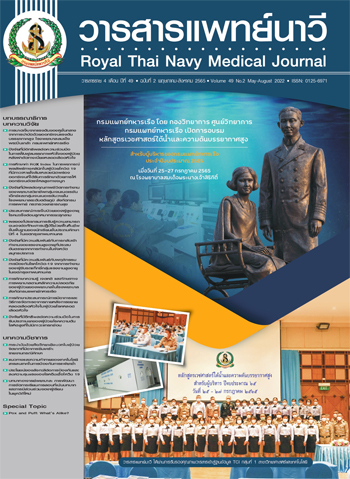การศึกษาประสบการณ์การมีอาการและวิธีการจัดการอาการภายหลังการขยายหลอดเลือดหัวใจในผู้ป่วยโรคหลอดเลือดหัวใจ
Main Article Content
บทคัดย่อ
การศึกษาครั้งนี้เป็นการวิจัยแบบบรรยายเชิงเปรียบเทียบ เพื่อศึกษาประสบการณ์การมีอาการและวิธีการจัดการอาการภายหลังการขยายหลอดเลือดหัวใจในผู้ป่วยโรคหลอดเลือดหัวใจ กลุ่มตัวอย่าง คือ ผู้ป่วยโรคหลอดเลือดหัวใจภายหลังการขยายหลอดเลือดหัวใจ ที่มาติดตามการรักษาแผนกผู้ป่วยนอก ระบบโรคหัวใจและหลอดเลือด โรงพยาบาลของรัฐระดับตติยภูมิในกรุงเทพมหานคร จำนวน 423 คน เก็บรวบรวมข้อมูลโดยใช้แบบสอบถามข้อมูลส่วนบุคคล แบบสอบถามประสบการณ์การมีอาการ และแบบสอบถามวิธีการจัดการอาการ โดยมีค่าสัมประสิทธิ์ KR-20 และค่าสัมประสิทธิ์แอลฟาครอนบาคของแบบสอบถามประสบการณ์การมีอาการใน 4 มิติ คือ มิติการเกิดอาการ มิติความถี่ มิติความรุนแรง และมิติความทุกข์ทรมาน ได้เท่ากับ 0.85, 0.85, 0.87 และ 0.86 ตามลำดับ วิธีการจัดการอาการด้านการเลือกปฏิบัติและประสิทธิผลของวิธีการจัดการอาการ เท่ากับ 0.90 และ 0.91 ตามลำดับ วิเคราะห์ข้อมูลด้วยสถิติเชิงพรรณนา สถิติทดสอบที และสถิติวิเคราะห์ความแปรปรวนทางเดียว
ผลการศึกษา พบว่า อาการภายหลังการขยายหลอดเลือดหัวใจ คิดเป็นร้อยละ 52.7 อาการที่กลุ่มตัวอย่างรายงานมากที่สุด คือ รู้สึกเหนื่อยง่าย/อ่อนเพลีย (ร้อยละ 67.7) ขาบวม เป็นอาการที่กลุ่มตัวอย่างรายงานความถี่มากที่สุด ( ± SD = 3.13 ± 1.19) และเบื่ออาหาร เป็นอาการที่กลุ่มตัวอย่างรายงานความรุนแรงและความทุกข์ทรมานมากที่สุด ( ± SD = 3.05 ± .97 และ 3.05 ± .97 ตามลำดับ) การนั่งหรือนอนพัก เป็นวิธีที่กลุ่มตัวอย่างเลือกใช้สำหรับจัดการอาการเหนื่อยง่าย/อ่อนเพลียมากที่สุด และมีประสิทธิผลอยู่ในระดับมาก (ร้อยละ 86.1) ( ± SD = 4.05 ± .96) และเมื่อเปรียบเทียบประสบการณ์การมีอาการภายหลังการขยายหลอดเลือดหัวใจ พบว่า เพศเป็นเพียงตัวแปรเดียวที่แตกต่างกัน อย่างมีนัยสำคัญทางสถิติที่ระดับ .05 (t = 2.59, df = 100.49, p = .01)
Article Details

อนุญาตภายใต้เงื่อนไข Creative Commons Attribution-NonCommercial-NoDerivatives 4.0 International License.
เอกสารอ้างอิง
Benjamin EJ, Muntner P, Bittencourt MS. Heart disease and stroke statistics-2019 update: a report from the American Heart Association. Circulation 2019;139(10):e56-e528.
Virani SS, Alonso A, Aparicio HJ, Benjamin EJ, Bittencourt MS, Callaway CW, et al. Heart disease and stroke statistics 2021 update: a report from the American Heart Association. Circulation: Cardiovascular Quality Outcomes; 2021: CIR.0000000000000950.
ICT MOPH. Mortality rate Cardiovascular disease 2020. Nonthaburi: Office of the permanent secretary of MOPH; 2020. (in Thai).
The Heart Association of Thailand under the Royal Patronage of H.M. The King. Thai acute coronary syndromes guidelines 2020. Bankok: Nextstep D-sign Limited Partnership; 2020. (in Thai).
Piva CD, Vaz E, Moraes MAG, Silvia, Linch nFdC, Souza ENd. Discomfort reported by patients after cardiac catheterization using the femoral or radial approaches. Revista Brasileira de Cardiologia Invasiva 2014;22(1):36-40.
Barker AL, Peeters G, Morello RT, Norman R, Ayton D, Lefkovits J, et al. Symptoms and feelings valued by patients after a percutaneous coronary intervention: a discrete-choice experiment to inform development of a new patient-reported outcome. BMJ open 2018;8(10):e023141.
Thanakitworabool J. Recovery health behavior patient with post acute myocardial infarction. [Master’s Thesis, Faculty of Nursing]: Christian University of Thailand; 2011. (in Thai).
Chang CC, Chen YC, Ong ET, Chen WC, Chang CH, Chen KJ, et al. Chest pain after percutaneous coronary intervention in patients with stable angina. Clinical Interventions in Aging 2016;11:1123.
Qintar M, Grantham JA, Sapontis J, Gosch KL, Lombardi W, Karmpaliotis D, et al. Dyspnea among patients with chronic total occlusions undergoing percutaneous coronary intervention: prevalence and predictors of Dyspnea among patients with chronic total occlusions undergoing percutaneous coronary intervention: prevalence and predictors of improvement. Circulation: Cardiovascular Quality Outcomes 2017;10(12):e003665.
Méa D, Pilla C, Bettinelli LA, Pasqualotti A. Anxiety and depression symptoms in adults and elderly in post-percutaneous coronary intervention. Acta Colombiana de Psicología 2018;21(2):236-57.
Phromsont W, Aungsuroch Y, Polsook R. Factors predicting depression among post-acute myocardial infarction patients. Royal Thai Navy Medical Journal 2019;46(3):592-606. (in Thai).
Iverson A, Stanberry L, Garberich R, Antos A, Sandoval Y, Burke MN, et al. Impact of sleep deprivation on the outcomes of percutaneous coronary intervention 2018;92(6):1118-25.
Dodd M, Janson S, Facione N, Faucett J, Froelicher ES, Humphreys J, et al. Advancing the science of symptom management. J Adv Nurs 2001;33(5):668-76.
Suksamai J, Nipatsiripol Y, Daengsri T,Samai T. A clinical nursing practice guideline on reducing back pain in patients after PCI. Siriraj Nursing Journal 2011;4(1):56-64. (in Thai).
Suwanratsamee W. Symptom experiences, symptom management, and functional status in patients with heart failure. [Master’s Thesis, Faculty of Nursing]. Mahidol University; 2012. (in Thai).
Phaisantum P, Duangpaeng S, Kunsongkeit W. Experiences of lifestyle modification among patient with acute myocardial infarction post Coronary stent placement. Thai Journal of Cardio-Thoracic Nursing 2018;29(1):96-109. (in Thai).
Su SF, Liao YC, Wu MS. Age and pain as predictors of discomfort in patients undergoing transfemoral percutaneous coronary interventions. Heart & Lung 2018;47(6):576-83.
Ayton DR, Barker AL, Peeters GM, Berkovic DE, Lefkovits J, Brennan A, et al. Exploring patient-reported outcomes following percutaneous coronary intervention: a qualitative study. Health Expectations 2018;21(2):457-65.
Ben-Yehuda O, Kazi DS, Bonafede M, Wade SW, Machacz SF, Stephens LA, et al. Angina and associated healthcare costs following percutaneous coronary intervention: a real-world analysis from a multi-payer database. Catheterization Cardiovascular Interventions 2016;88(7):1017-24.
Aldwin CM, Igarashi H, Gilmer DF, Levenson MR. Health, illness, and optimal aging: biological and psychosocial perspectives: Springer Publishing Company; 2017.
Dabbagh A. Postoperative pain management in adult cardiac surgery. In: Dabbagh A, Esmailian F, Aranki S, editors. Postoperative critical care for adult cardiac surgical patients 2nd ed. Cham: Springer International Publishing; 2018. p. 527-63.
Aroonsan P. Cardiovascular nursing. 11th ed. Khon Kaen: Klungnana Vitthaya Press; 2017. (in Thai).
Cochran WG. Sampling techiques. New York: John Wiley & Sons; 1977.
Zipes DP, Libby P, Bonow RO, Mann DL, Tomaselli GF, Braunwald E. Braunwald's heart disease: a textbook of cardiovascular medicine. 11th ed. Philadelphia: Elsevier Health Sciences; 2019.
Farzam K, Jan A. Beta blockers. Treasure Island (FL): StatPearls Publishing LLC.; 2021.
Soh SE, Barker AL, Ayton DR, Ahern S, Morello R, Lefkovits J, et al. What matters most to patients following percutaneous coronary interventions? a new patient-reported outcome measure developed using Rasch analysis. PloS one 2019;14(9):e0222185.
Ritpetch N. Relationships among symptom clusters, self – management, health value, sense of coherence, and health - related quality of life in patients with percutaneous coronary intervention. [Master’s Thesis, Faculty of Nursing]. Chulalongkorn University; 2012. (in Thai).
Jing YY, Luan DC, Li LD. Vagal baroreflex activation resulting in acute coronary stent thrombus associated with myocardial infarction: a case report. J BMC Cardiovascular Disorders 2014;14(1):131.
Davis MP, Walsh D. Mechanisms of fatigue. J Support Oncol 2010;8(4):164-74.
Kronkasem A, Wattanakitkrileart D, Pongthavornkamol K, Kanoksin A. Fatigue experience, symptom management strategies, and functional status in patients with congestive heart failure. Journal of Nursing Science 2014;32(4):35-42. (in Thai).
Eltumi HG, Tashani OA. Effect of age, sex and gender on pain sensitivity: a narrative review. The Open Pain Journal 2017;10(1).
Orem DE, Taylor SG, Renpenning KM. Nursing concepts of practice. 5th ed. St. Louis : Mosby; 1995.

